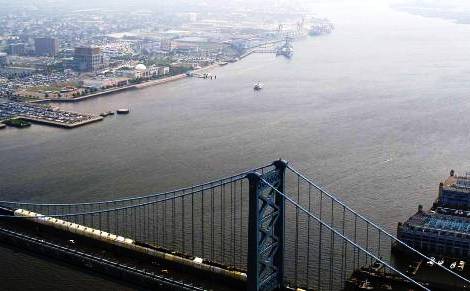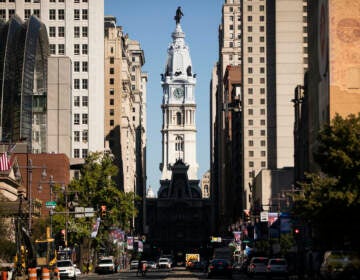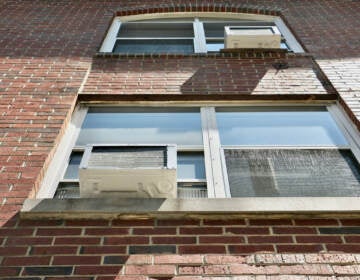Two cities, one waterfront goal?

By Alan Jaffe
For PlanPhilly
In the early 1800s, seven ferry systems crossed the Delaware from Philadelphia to the colony called Cooper’s Ferry, a tourist attraction of inns, taverns and gardens.
Today, Camden and Philadelphia are linked by just one ferry, and a bridge that carries most riders over and past the New Jersey city.
As urban designers on the Pennsylvania side reconsider ways to bring new life and commerce to the Delaware Riverfront, their counterparts in New Jersey hope to join the discussion and forge plans that will reconnect and benefit both sides. Their progress in Camden and elsewhere may even serve as models for Philadelphians.
At the design workshop on the seven-mile riverfront sponsored by PennPraxis in early March, Peter Reed, a curator in the architecture and design department of New York’s Museum of Modern Art, said planners had been somewhat near-sighted by not including New Jersey in their vision.
In an interview last month, Reed, who lived in Philadelphia from 1980 to 1992 and was a Penn student and faculty member, said city planners should be thinking about “larger connections” between the two states. In his travels around the world to study waterfronts, he found other cities focused on both sides of the river. Redevelopment of waterfronts in Shanghai, Bordeaux and London involved single cities that had to work with historic sides and industrial sides. Philadelphia and Camden have to grapple with two former industrial sides, but they can reconnect residential and commercial aspects with ferries, just as Manhattan has done with its neighboring New Jersey communities. The cities could also create parallel parkland strips, said Reed, whose last project at MoMA was on American landscapes that redeveloped industrial space using parks as a catalyst. Together, the two riverfronts could create a “magnet, a place to attract rather than avoid.”
“The image of [Philadelphia] has rarely been of the riverfront, or from the riverfront,” Reed said. While the Schuylkill has Boathouse Row, will the Delaware be represented by casinos and condos, he asked. “What is the ambition? What will be the new face of the city, symbolically?”
Thomas Corcoran suggests the aerial tram.
And, indeed, the project that was intended to link the two cities is currently a symbol of good intentions that never got off the ground.
Started in December 2000, the footings for the Camden-Philadelphia tram were finished on the Pennsylvania side in 2001 and on the Jersey side in 2002, and the entire project is two-thirds funded. When it’s operating, the cross-river tram should be able to carry 2,000 riders per hour. But right now, the project is inactive (with a January 2008 restart date); there’s no place for the gondolas to land on Penn’s Landing; and only one-fifth of the estimated total project cost of $75 million has been spent.
“The project is still going on,” said Corcoran, president and CEO of the Cooper’s Ferry Development Association, which has coordinated more than $500 million in private and public investment in the Camden waterfront. “The only reason that tram hasn’t happened is because of Penn’s Landing.” Under proposals in 1997 as part of the Simon DeBartolo project, the tram would have set down atop a garage near a shopping area. When the DeBartolo plan fell through in 2002, “everybody went back to ground zero,” Corcoran said.
“The tram itself will be the icon of Two Cities-One Waterfront,” a marketing concept forged by CFDA that foresees a unified tourist destination made up of Camden’s attractions, Penn’s Landing and Philadelphia’s historic district. “There really is strong synergy between the two cities,” Corcoran said.
For 22 years, CFDA has been working on improving perceptions and realities in Camden, and reviving its ties to Philadelphia. Corcoran offers a quick history lesson on the Jersey waterfront and the association’s role:
In the 1920s, industrial Camden was “not a very pretty place, but it was thriving.” In the year before the Ben Franklin Bridge opened, the ferry systems carried 20 million passengers, Corcoran said. “The economies of Philadelphia and Camden were inextricably linked. You had people living in Philly and working in Camden at Campbell Soup or RCA or the shipyard, and you had people living in Camden working over in the industrial areas of Philadelphia. Once the bridge was built, the ferry system died out, and the bridges became a way that people could drive through Camden without having to go through it, seeing it, and experiencing it.”
In 1984, when CFDA was organized as a citywide economic development corporation, the Camden waterfront was a series of abandoned factories and railroad tracks. “You could see the tumbleweeds just rolling down,” Corcoran said.
One of the first goals was to expand the remnants of a park promenade. “It ties the whole waterfront together and really makes it a public place,” Corcoran said. “In Pennsylvania, there is no absolute requirement that to do waterfront development, you have to create public access. In New Jersey, it’s an absolute rule; you have to provide a minimum of 35 feet of dedicated parkland between the river and any development. Pennsylvania would benefit from a regulation like that.”
All the streets in downtown Camden used to end at Delaware Avenue, Corcoran continued, and the waterfront was inaccessible. As the parkland was built up, those streets were brought down to the water. “So we’ve really made the waterfront an extension of downtown Camden.”
Corcoran lists the projects realized along the waterfront so far: the aquarium, L-3 Communications, Tweeter Center, One Port Center, Camden Children’s Garden, Campbell’s Field, Battleship New Jersey, Wiggins Park and the Victor Lofts.
A ferry system between the two cities has been revived and carried 300,000 passengers last year. If the casinos come to the proposed sites on the Philadelphia waterfront, the ferry service will expand to locations on the Jersey side that will meet visitors’ needs, he said. “We’re very opportunistic. If the casinos come, we want to make sure the people have something to do first, and stop and eat on the way back.”
Connecting New Jersey’s river towns from north to south is the Trenton-Camden light rail line, which opened in 2004 and is now carrying 7,000 passengers a day. It also provides linkage to Philadelphia by way of the PATCO line.
The PATCO High-Speed Line carries on the role of the old ferries, transporting an estimated 4 million passengers from New Jersey to Philadelphia in 2005, the last year for which data was available, and another 3.9 million from Philadelphia to New Jersey on the rail line that clings to the side of the Ben Franklin Bridge.
Camden resident Kristy Ebrack, 24, is one of those PATCO riders, traveling from her home in Royal Court near the Tweeter Center to her job at the University of Pennsylvania in a 15-minute commute each day. The 24-year-old New Yorker moved to Camden in September, choosing a home there for its lower cost of living. She has never crossed the river by ferry, but would consider the tram. “If it could match the $2.10 roundtrip fare PATCO offers its Camden residents, I would use it.”
When Ebrack doesn’t take the speed line, she drives, like most commuters. The Delaware River Port Authority counted 19.6 million vehicles passing through the westbound tollbooths of the Ben Franklin Bridge in 2006, which extrapolates to a total of 39.2 million cars and trucks crossing the bridge last year, according to a DRPA spokesman.
Ebrack said she is not a frequent visitor to the Camden waterfront attractions, but she does believe the area is “up and coming.”
The Cooper’s Ferry projects along the river together pay $4 million in taxes to Camden, and “with full buildout” of planned improvements – including the Cooper’s Crossing residential and commercial project – Corcoran said tax revenues will reach $12 million, “which will increase the city’s tax base by 50 percent.”
For Camden, however, it is still vital to be included in Philadelphia’s waterfront planning, “because part of our future is being relinked” to its cousin across the river, Corcoran said. “And I would say it’s very important for Pennsylvania and Philadelphia, because we have a lot to offer on our side.” The Camden attractions, Corcoran said, are drawing 2.5 million visitors a year, compared to 1 million visiting Penn’s Landing.
Partly responsible for keeping the two cities apart has been the debate over dredging the Delaware to increase its main channel depth to 45 feet, thereby allowing larger tankers to reach Philadelphia docks. New Jersey officials have resisted the dredging project for environmental concerns; they fear threats to wildlife and relocation of the dredge spoils.
The conflict has divided the bi-state Delaware River Port Authority. Gov. Rendell and the Pennsylvania delegates began boycotting the meetings in November 2005. The Jersey members continue to meet monthly, said vice chairman Jeffrey Nash. “Both governors have met and discussed the issue at length,” Nash said in interview last month. “They recognized that there must be give and take, and they’re working on it. But I don’t know if it will come to fruition any time soon.”
If the dredging issue can be settled and the DRPA reunited, the authority could provide the final one-third of funding for the aerial tram from its capital budget, according to Corcoran.
Tram systems are slowly gaining in popularity across the country. A gondola line at the ski mecca of Telluride, Colo., has become a very successful metro transit system, said Sid Roslund, director of technical services for the National Ski Areas Association. There is also a new tram system in Portland, Ore., he said, that travels from the riverfront to a city hospital, serving as a lateral elevator to the facility situated on a landlocked peak. “The trams are able to go places other forms of transportation can’t.”
Roslund, who administers national standards for lift devices used by the ski association, said the tram systems are “very, very safe.”
A power failure that stranded 69 passengers on New York’s Roosevelt Island Tramway for seven hours in April 2006 was due to a “power spike” that took out the auxiliary system, Roslund said. “When something stops, it’s usually from an outside source,” he said. “This year, there have been stoppages of some systems, but they were working within an hour.”
There have also been collisions of tram cars, including an accident in Scotland in July 2006 that injured five people. Most tram accidents, Roslund said, have occurred in “the 1970 generation of gondola systems.” Newer tram systems have “complex monitoring” that prevent a gondola from entering the zone of another, he said.
The Delaware River system, however, remains “on hold, pending what happens at Penn’s Landing,” said the DRPA’s Jeffrey Nash. The Philadelphia side “has been stuck because of the structural problems on its side,” said Nash, referring to the proximity of Interstate 95. The DRPA anticipates that the awarding of tram bids will continue into late 2008 and the opening of the tram would not occur before mid 2010.
While it awaits progress on the Philadelphia side, CFDA is continuing plans to expand redevelopment. “Camden has about 10 miles of developable waterfront,” Corcoran said, and the current attractions and structures only cover 1.3 miles. The only neighborhood that has directly benefited from those projects has been the Cooper Grant area around the Rutgers campus, where home values have “probably tripled as the waterfront has picked up momentum.”
The next target is North Camden, probably the poorest neighborhood. The CFDA is meeting with community groups to explore ways to develop land north of the Ben Franklin. Gov. Corzine is considering phasing out the state prison, and if that goes, Corcoran said, it would allow continuation of the parkland. Then easements will be negotiated with private landowners, and the streets will be extended to the water. “We can create market rate and affordable housing near the waterfront and create a really nice community. It shows how waterfront development could really spur neighborhood development.”
Corcoran asks Philadelphia planners to see the possibilities, too. “I understand their narrow task is how to make it best to tie together the seven miles of their waterfront, and rectify the sins of the past and make things better for the future. But while they’re doing that, they should be looking at the linkages to New Jersey.
And it’s not just Camden. It’s also Deptford Township near the airport, it’s Gloucester City, it’s Pennsauken, all the way up to the river towns. Each of those towns has got something to offer to make this a richer experience for tourism, or to live,work and play.”
Corcoran also suggests the two cities think about ideas “like someday running a high-speed ferry from the Waterworks, or the Zoo, that would come down the Schuylkill, have a stop at the Navy Yard, a stop at RiverWinds in West Deptford, come up to our waterfront, and go to the casinos. You can really tie everything together, and it should be tied together.”
From the beginning of CFDA’s creation, he said, “we wanted to see the two waterfronts develop in tandem and someday operate in tandem as a single destination with exciting things to do on both sides, tied together by interesting modes of transportation. … And whether you parked on the Philadelphia side and came over to Camden, or vice versa, you wouldn’t be aware of the artificial political line that runs down the middle of the river.”
Discussions on the Philadelphia waterfront redevelopment continue, and will expand, PennPraxis’ Steinberg said earlier this month.
Invitations to past meetings have been widely distributed, Steinberg said, and “we are not not inviting New Jersey. But we could probably do a better job of thinking regionally.”
He noted that the bi-state DRPA is on the PennPraxis advisory board and is represented at its meetings. The Philadelphia planners have not targeted specific South Jersey towns where riverfront projects are underway or on the drawing board, “but that is something worth talking about.”
Recalling Peter Reed’s points at the design workshop, Steinberg said the Delaware River waterfront is “a regional asset. …We need to be thinking across the river as well as up and down it.”
Alan Jaffe is a former assistant Pennsylvania editor at the Philadelphia Inquirer. He was the courts, crime and breaking news editor in the suburban office, and also was an assigning editor in Bucks County and southern New Jersey. Before joining the Inquirer in 1999, he was the features editor at the South Jersey Courier-Post.
WHYY is your source for fact-based, in-depth journalism and information. As a nonprofit organization, we rely on financial support from readers like you. Please give today.






